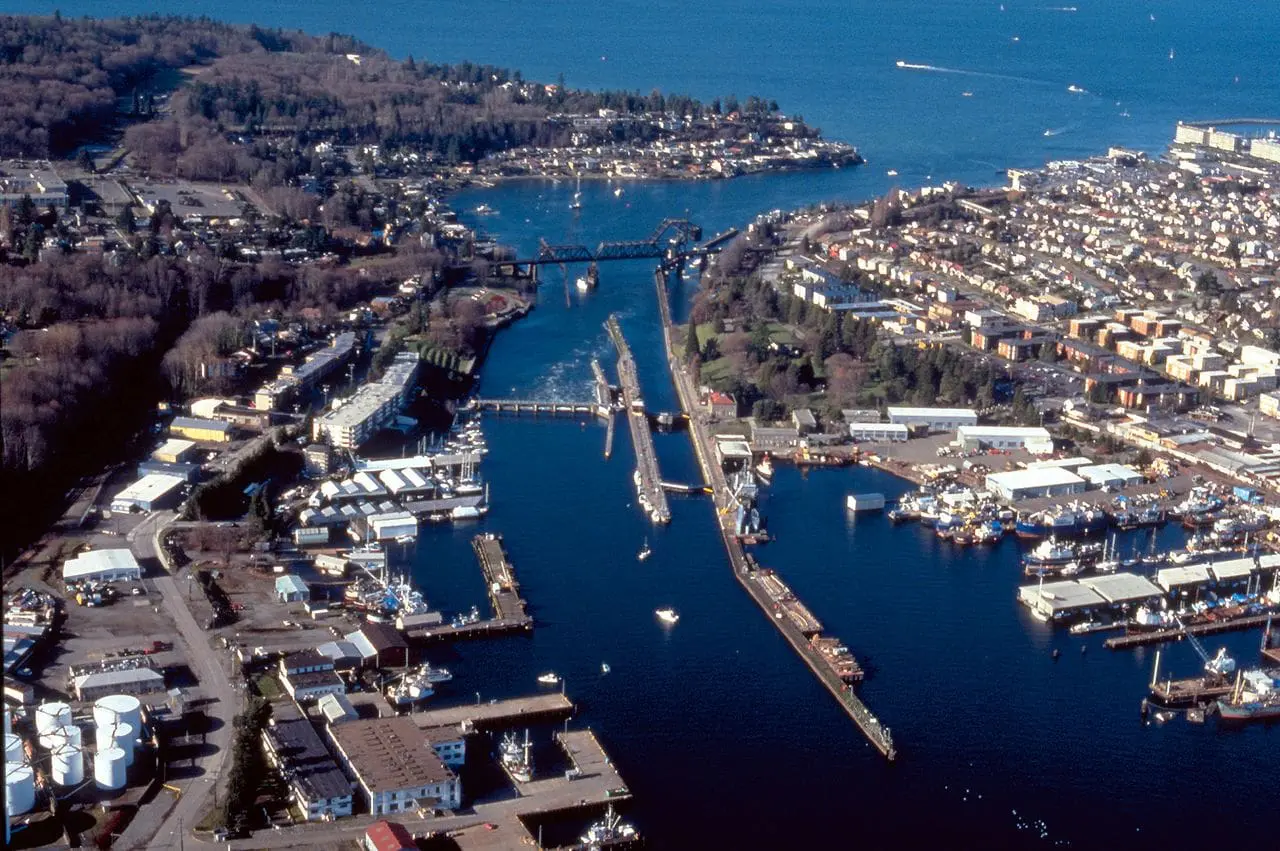
$13M in Federal Funding Dedicated to Fish-Friendly Fixes at the Ballard Locks
Over the last year, Long Live the Kings has been forging new partnerships and making new connections up and down the Lake Washington Ship Canal. We’re part of a loose coalition of diverse interests: commercial fishing companies, boat maintenance yards, the Port of Seattle, American Waterway Operators and the Lake Washington-Cedar-Sammamish Watershed Salmon Recovery Council, among others, working to ensure that the Ballard Locks get the attention and funding they deserve to remain open and facilitate safe fish migration.
What is the issue at the Locks?

The large Locks chamber during an annual clean-out.
For anadromous fish like salmon, the Ballard Locks represent the biggest barrier in the watershed. All salmon have to navigate the Locks to go to the ocean and return to spawn, running the gauntlet of 100-year-old machinery and a patchwork of workarounds. The fish ladder functions as it should for returning adults, but as they travel through the large and small Locks, they risk injury by getting pulled into saltwater drains. The small salmon smolts (outmigrating juveniles) face even more danger. They “go with the flow” and end up exiting the Locks one of two ways: the lucky smolts exit via slides or flumes installed by the Army Corps of Engineers for safer passage, while the unlucky ones get sucked into the filling tunnels and scraped along rough, barnacle-covered walls – more on that and photos below!

Barnacle-encrusted filling tunnels inside the large Locks. These rough surfaces can badly injure or even kill small fish.
Managers have known about these issues since a plan to recover Chinook was written in 2005. The Army Corps of Engineers partnered with the Salmon Recovery Council to make temporary fixes and minor improvements, but funding for permanent fixes and improvements for passage was the primary barrier (no pun intended). The erroneous notion in Washington DC had been that the Ballard Locks were largely a recreational and tourist amenity, and so we were unable to access maintenance dollars when competing with the big, commerce-moving infrastructure of the Mississippi or even the Columbia River facilities. Thanks to our new Ship Canal partners, that notion was put to rest when they commissioned a study to demonstrate the huge value of the Locks, which provide a freshwater port on Puget Sound for the Alaskan Fishing fleet and an entire maritime industry. They estimated over $1.2 billion in annual economic losses to the maritime industry alone if the Locks were to fail. We credit this study as catalyzing our coalition of partners who welcomed the “salmon interests” into their fold and together we worked with the Washington congressional delegation and every level of US Army Corps of Engineers to make the problem and solution well understood.
What is the solution?

Tour attendees standing in front of the old large locks filling tunnel gate. The list of necessary upgrades for the Locks includes replacing this gate.
The solution is a suite of projects for the 101-year-old structure, making a series of necessary upgrades and replacements to ensure the continued operation of the Locks while also improving survival of juvenile and adult migrating salmon. This series of projects will take several years to complete and we will need to keep up the pressure to fund them and see it through. The project that benefits fish most happens to be the first project on the list, so it won’t be long before we see a benefit to sockeye, Chinook, and coho salmon. The project entails replacing the valves and machinery of the ‘filling culvert’ mentioned earlier: a huge tunnel that moves lake water into the large lock to fill it during a lockage (when a vessel is raised or lowered to the the appropriate water level). The upgrades allow the culvert gates to open and close at different speeds to slow the velocity of water entering the locks during the smolt outmigration. This improvement, along with the smolt slides and flumes that you see as you walk across the dam at the Locks, should markedly increase the number of smolts that experience safe passage from the Ship Canal to Puget Sound.
Very importantly, the overall safety and functionality of the Locks is being improved. Last year’s funding was approved to replace a crane for the emergency closure system. Now the large Lock filling mechanism marks the project with the highest price tag on the list. Future projects involve seismic retrofits and a new screen on the saltwater drain so fish don’t get entrained (stuck) there.
There is more to do but let’s take a minute to celebrate this victory for fish and infrastructure in Puget Sound!
What can you do?
- Help us thank our Congressional leaders, especially Senator Patty Murray and Rep. Pramila Jayapal.
- Want to tour the large Locks and filling tunnel? Every year the Army Corps of Engineers empties each Lock at different times and conducts a series of safety checks and tests. They also scrape barnacles from inside the filling tunnel. The public can sign up to join a tour. Sign up here.
- Support LLTK to help advocate for salmon and steelhead in Olympia and Washington DC. Most of our grant funds can’t be used for this sort of effort, so we rely on individual donors to be able to leverage partnerships, meet with elected officials, and be a voice for salmon.
Cover image courtesy of: By Unknown Photographer / US Army Corps of Engineers – [1], Public Domain, https://commons.wikimedia.org/w/index.php?curid=480030
All other images courtesy of Eric Hall, ehall Photo: https://www.flickr.com/photos/ehall/